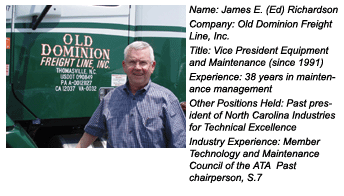Old Dominion’s Ed Richardson blends experience and forward thinking into maintenance program Ed Richardson has been in the biz a long time.
Prior to coming to Old Dominion twenty years ago, he had already dried behind the ears and was on a clear path toward a manager’s spot in maintenance. Richardson has watched the industry change and with it, he has experienced first hand the way equipment has changed and how repair and maintenance followed suit. From Richardson ’s perspective, the tricks of his trade have been learned first hand over his entire career.

“Twenty years ago, I could get hands on. But in those days Old Dominion had only 300 trucks. We have 5,300 now and that has forced me into an entirely supervisory role.” Now vice president of equipment and maintenance, he has a staff and has split up Old Dominion’s maintenance domain into regions with a director over the whole shebang and a field manager for each of eight regions.
Growth has been good to Old Dominion and to Richardson . But growth always brings problems, and as technology has sped up the pace of change, a growing fleet like Old Dominion has had to invest in the future without spending themselves out of business. Richardson is not one to buy every new technology that comes down the pike. His trick, like many another big fleet manager, is to wait until the technology is proven and the bugs have been exorcised. This also saves capital by allowing the price to drop. At the VP level, Richardson has to understand where the money is and where it can best be used.
Nevertheless, Old Dominion boasts plenty of upgrades to enhance safety including lane departure sensors made by Iteris. Mostly though, Richardson sees the improvement in reliability and durability of equipment as a major change and an improved driver environment, including power steering, cruise control, diff locks, jakes. adjustable seats, air conditioning. As equipment has improved, the repair and maintenance focus has shifted.
“We used to get 200,000 miles out of an engine. Now we get 1,000,000 and we have fewer problems.” So the maintenance issues have gone from doing major repairs in-house to jobbing out the big stuff like overhauls. The continuous training of technician for increasingly technical work is also an issue.
Government regulation is of course another impetus for continual training. “We have two full time trainers,” Richardson notes, “So our techs have the information they need on a regular basis.” And with EPA ’07 and 2010 coming up, the need for tech education runs steadily forward. “We do not have much trouble with the ’07 engines yet, but we’ve only had a few running for about 50,000 miles. We are keeping our eyes open for problems in the next 50,000 miles. Our technicians will be ready for those issues.” Richardson did not pre buy he told me. “What we’ve done is strategic equipment replacement. We traded older trucks and bought early in the year than usual, that’s all.”
Richardson says that peripherals to the engine cause new problems with every new model and set of regulations. “The engineers can change the location of water pumps, hoses, belts, steering hardware, with every new model and new regulation and when you get a new location, you need to watch for problems.”
Still, Richardson is not a fan of predictive maintenance. “My pet peeve is replacing a water pump, for instance, before it lets go,” he re-marked. As for the biggest problem he faces today, “It’s obsolescence” he says. Changes happen so frequently that trainers must also be trained and technicians must invest in new tools on a regular basis. “My idea of predictive maintenance is to spec a vehicle up front. The life span has been extended to a million miles and I see no need to carry a lot of paper and manpower to analyze it when I know what to expect.”
Not all maintenance and repair issues need new tools, continuing education, and testing to keep the fleet productive. Richardson says his most common problem is broken airlines on triples and doubles. “Triples and doubles just have more air and electrical lines to worry about” he says. Driver error and exposure cause most of the problems. But wiggle wagons provide plenty enough more revenue to make the repair issue pale. Such issues won’t go away anytime soon and techs will continue to get their hands dirty despite new technologies and computer based diagnostic tools.
What we have here then is a lifetime of experience that has not become a concrete block. Richardson has chosen to let experience guide him while being flexible enough to change as the times demand. This is perhaps an attitude one might devoutly wish to assimilate in an age where progress is measured by the ability of fleets to keep up without going under.
